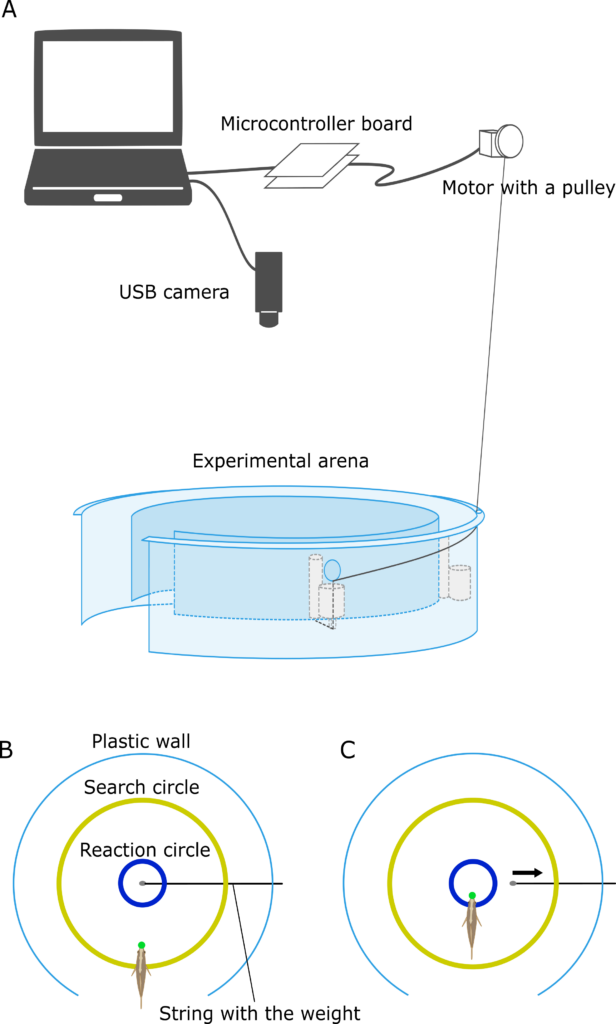2024.05.13
Revolutionary Device Developed to Automatically Detect Predators to Enable Swift Escape of Prey
Points:
● A device that can adjust various variables such as distance to detect predators, time to react, and speed.
● The time it takes for the device to react to predator detection can be set to a minimum of approximately 0.07 seconds.
● The maximum average speed at which the prey can escape can be set to 1 meter per second or more.
● The reaction time and speed of the device are comparable to those of actual prey (small fish and insects), making it applicable to various experiments.
Summary:
Associate Professor Yuuki Kawabata of the Graduate School of Integrated Science and Technology (at the time of research, Graduate School of Fisheries and Environmental Sciences), Nagasaki University, who specializes in animal behavior, in collaboration with Professor Koichi Hashimoto of the Graduate School of Information Sciences, Tohoku University, who specializes in computer vision, has developed a device that automatically detects approaching predators and allows the prey to escape.
When the USB camera installed on top detects an approaching predator (predator intrusion into predetermined circles), the device activates the motor, and the prey escapes (Figure 1).

Research Background:
When facing a predator or other danger, many animals try to avoid it by fleeing. Whether an animal can escape or gets caught depends on its behavioral characteristics, such as when it starts running away, which direction it flees, and how it is chased by predators, in addition to its ability to move quickly, such as its speed. Identifying these factors is important in behavioral, ecological, and evolutionary biology fields because it helps to determine which traits are likely to survive and which traits have evolved.
Although it is useful to analyze how predators attack and how prey defend themselves, it is impossible to determine the importance of a particular behavior or movement if there is no variation in that aspect of the organism being studied. For example, if escape velocity is considered important for avoiding predators, but the velocities of all prey are nearly identical, we cannot test whether it is essential. In such cases, manipulation experiments, in which the speed of the prey is varied to be “slow” or “fast” and then fed to the actual predator, are helpful. However, conducting such experiments for small fish and insects is challenging as they react instantly and escape at high speeds (1 meter per second or more). Therefore, a device with similar kinetic performance was required.
Significance of Research Findings:
The device that has been developed has the capability to analyze the effective prey characteristics that can be used to avoid predator attacks by studying a variety of predators. It can also be used to examine the behavioral and kinematic characteristics of predators such as how they react and track their prey. Although our assumption was based on an underwater experiment using fish as predators, it can also be utilized for conducting experiments with land-based predators like lizards and frogs.
Acknowledgements:
This research was supported by Grant-in-Aid for Scientific Research (Grant-in-Aid for Scientific Research on Innovative Areas: 19H04936).
References:
Journal: The Journal of Experimental Biology(Impact Factor = 2.8)
Title: Automated escape system: identifying prey’s kinematic and behavioral features critical for predator evasion
Authors:
Nozomi Sunami
Faculty of Fisheries, Nagasaki University
Hibiki Kimura
Graduate School of Fisheries and Environmental Sciences, Nagasaki University
Hidechika Ito
Department of System Information Sciences, Graduate School of Information Sciences, Tohoku University
Koichi Hashimoto
Department of System Information Sciences, Graduate School of Information Sciences, Tohoku University
Yuta Sato
Faculty of Fisheries, Nagasaki University
Soki Tachibana
Faculty of Fisheries, Nagasaki University
Mikiya Hidaka
Graduate School of Fisheries and Environmental Sciences, Nagasaki University
Kouki Miyama
Graduate School of Fisheries and Environmental Sciences, Nagasaki University
Hirofumi Watanabe
Faculty of Fisheries, Nagasaki University
Yuuki Kawabata
Faculty of Fisheries, Nagasaki University
Graduate School of Fisheries and Environmental Sciences, Nagasaki University
Published date: 2024/5/1
URL:https://doi.org/10.1242/jeb.246772
